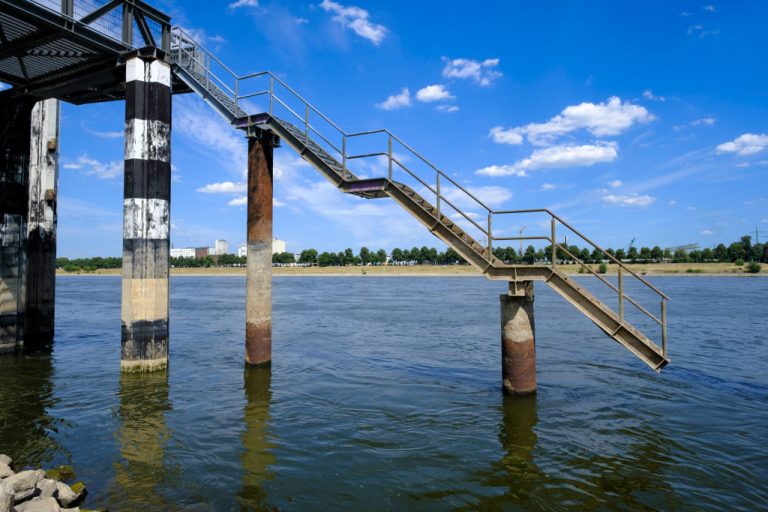The Rhine River, a major thoroughfare via Germany that connects the Netherlands, France, and Austria, is running dry, causing major disruptions to both European industry and energy supplies.
The massive heat wave that rocked much of Europe in July caused water levels on the Rhine to sink to lower levels, and at a faster pace than normally seen, DW reported on July 21.
One of the major problems, several experts told the outlet, is that the low levels have required cargo ships, which transport more than 195 million tons of everything from diesel to gasoline to food annually, to carry only half their regular capacity so as to not bottom out.
Because of the restriction, more ships must be contracted to move the same amount of goods, leading to both a shipping backlog and higher costs.
At the time, the Steag coal-fired power plant in Essen stated during a press release that their facility had no more than a week’s supply of coal remaining for electrical generation.
Success
You are now signed up for our newsletter
Success
Check your email to complete sign up
Aug. 7 reporting by Politico stated that the crisis is giving the European Union and its plans to shift 25 percent of goods transports away from roads and into waterways as part of the controversial United Nations Agenda 2030 “Sustainable Development Goals” a wakeup call.
MORE ON DROUGHT AND THE ECONOMY
- City in New Mexico Only Has 50 Days of Water Remaining, Declares State of Emergency
- World’s Top Producer of Ammonia, a Key Component in Fertilizer, Slashes Production Amid German Energy Crisis
- Worn-down Wind Turbines Headed to Landfills Because Recycling Is Too Expensive: Study
- Amid Record Heatwave, Europe Discovers Solar Panels Inefficient in High Temperatures
President of the General Directorate for Waterways and Shipping (GDWS), Hans-Heinrich Witte, told DW that although transitioning to water shipments plays “an important role to play in meeting Germany’s climate goals,” unfortunately, since 2018, Witte had not seen “anything concrete that would help shipping meet the challenges of low-water situations presently and going forward.”
Politico stated that water levels were as low as 49 centimeters (~19 inches) at a crucial bottleneck located in Kaub.
And noted, “Levels at the Kaub chokepoint are already lower than they were at the same point in 2018 ahead of that October’s historic low of 25 centimeters (~9.8 inches).”
“The water was so low then that the river was closed to ship traffic for weeks, forcing companies to switch their freight to railways and roads. But that’s costly and inefficient since it takes hundreds of trucks or train cars to handle cargoes that can be loaded onto a single barge,” the article added.
This number, as shocking as it sounds, casts an even more somber hue in light of reporting by Reuters just days earlier on Aug. 3, which said Kaub was 61 centimeters (~24 inches) deep.
The article put the economic consequences into context. The cost of contracting a liquid tanker barge in the area had risen 7 Euros in a single day to €87.
In June, before water levels fell, the cost was only €20.
And if it isn’t drought, it’s flooding. In 2021, Germany and the Rhine faced exactly the opposite problem when the thoroughfare had to be shuttered because excess rain had driven the level at Maxau to 750 centimeters (~295 inches), the Independent Commodity Intelligence Service reported.
Regulations require traffic to be stopped when the water level is above 650 centimeters (~255 inches).
Not only overseas
Water disasters are also ravaging the United States.
Lake Mead, a critical body which nourishes 60 percent of U.S. agriculture and provides electricity to millions of people, is not only at levels unseen in 20 years, but appears to be dying, based on recently released NASA satellite imagery.
Mead is so dry that human skeletal remains, which once resided at the bottom of the water, have been uncovered, according to the National Parks Service.
California’s droughts, likewise, have rendered 800,000 acres of farmland, amounting to roughly 1,250 square miles, to idle unused this year as farmers face tough choices about what they can grow.
The location of the land idled is one that supplies 60 percent of U.S. agricultural production.
The U.S. beef industry has also been hard hit. Recent USDA data shows that the national cattle herd has decreased to levels not seen since 2016 and 2012.
Although the figure is alarming on its own, what is more ominous is that ranchers have been sending large amounts of breeding stock to feed lots in preparation for slaughter as a result of the water crisis.
If farmers cannot water and cool their animals, there are limited ways to solve the problem.
A reduction in the overall herd size combined with a loss of breeding stock will have significant effects in the years to come, as it takes at least 40 months for a newly born cow to grow to the state ready for processing.
Another major drought-linked inflection point can be found in India, which has already lost 13 percent of this year’s rice crops to drought.
India accounts for 40 percent of global rice exports, dwarfing its competitors.







